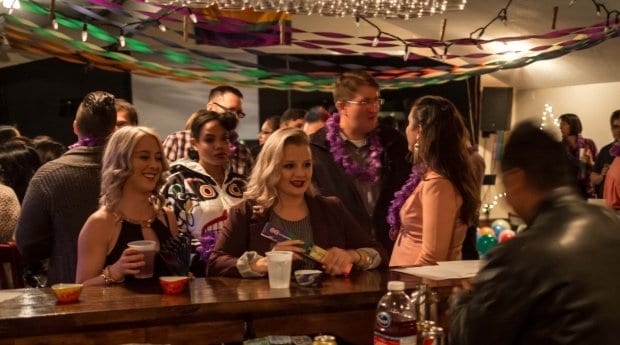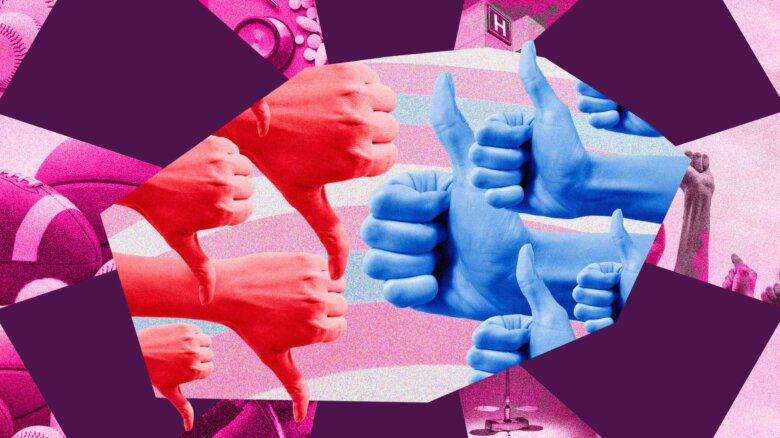Somehow, out of the controversy over a flag came the idea for a party.
It began when the city of Iqaluit raised a rainbow flag at city hall to protest anti-gay laws in Russia during the 2014 Winter Olympics, at the initiative of city Councillor Kenny Bell and Iqaluit resident Anubha Momin. Councillor Simon Nattaq argued that the decision had not been approved by council, and Nunavut Tunngavik Inc president Cathy Towtongie commended Nattaq for speaking out. These events sparked lively discussion among the residents of Nunavut about same-sex issues, including whether it’s within Inuit custom to be gay.
In the midst of this discussion, the idea for a party emerged, specifically, an Iqaluit Pride party, the first of its kind in the capital city of Nunavut.
The woman behind the party is Michelle Zakrison, a newcomer to Iqaluit. “I just moved here in May and started Iqaluit Pride,” she says. “I’ve volunteered with a lot of Prides, and I’ve been in student politics and that kind of stuff for a long time. I thought if I came up, I’d like to support whoever’s doing that, organizing that up here. After I talked to a bunch of people, nothing seemed to be going on. I thought, Well, I’ll create this Twitter [@Iqaluit Pride].”
The Twitter account was soon followed by a new Facebook group, then plans for the big Iqaluit Pride party, which took place Sept 27.
The party is the latest in a long series of steps toward same-sex rights and presence in Nunavut, all developing within the unique context of Canada’s newest territory.
***
Maureen Doherty first moved up north in 1983 and later came out as a lesbian at the age of 50. Along with Peter Workman and Allison Brewer, she has been actively involved in the same-sex-rights movement for more than a decade in Iqaluit.
“It started off with a small picnic, and then it grew,” Doherty recounts over the phone. “That particular summer of 2004 or 2005, we had huge Pride picnics. In fact, if politicians weren’t there, they came up to you and explained why they weren’t there, lest it be construed they might be homophobic. It was really quite exciting.”
These events unfolded around the same time that the Nunavut Human Rights Act was passed into law in 2003. During this time, there was much debate about whether sexual orientation should be included as a prohibited ground of discrimination. As a member of the steering committee for the legislation, Doherty recalls the discussions: “As well as there being a lot of support for the LGBT community, there was also a lot of concern and a lot of fear and homophobia. But the good thing is that it came out, because there was discussion all across Nunavut about this act and what it would mean and what human rights are. It was actually heartwarming to hear some of the things people had to say, about how historically there had been a place of acceptance in the Inuit culture.”
Ultimately, sexual orientation was included as a prohibited ground of discrimination in the Nunavut Human Rights Act, although gender identity was not. But does that translate to a homophobia-free reality in Nunavut?
***
For many openly gay and lesbian southerners in Iqaluit, their experiences have generally been positive.
Gerry Delaney, the gay performer behind drag persona Zsa Zsa LaWhore, has been living in Iqaluit for almost seven years. “I haven’t really experienced much homophobia other than a few things said here and there to me,” he says. “For the most part, it’s kind of a live-and-let-live situation. I don’t hide anything about my sexual orientation, but I don’t generally push it either. Even as a drag queen, I don’t get bothered too much.”
Natalie O’Grady, a 30-year-old lesbian originally from Halifax who has been in Iqaluit for six years, seems to agree. “The only place I’ve experienced homophobia was in New Brunswick,” she says.
But the experience is not the same for everyone, everywhere. For Inuit people, responses vary, particularly outside the capital city of Iqaluit.
“In 1995, I brought home my girlfriend from Montreal, and shortly after [my father] supported a bill in Parliament [to support gay and lesbian rights],” says Sky Aurora, the daughter of former member of Parliament Jack Anawak. “Both my parents support me relentlessly.”
However, she says, her sister was less supportive and even beat her when she found out.
At age 23, Jason Koblogina is one of the few openly gay Inuk men in Cambridge Bay, a small community of approximately 1,700 people located on the other side of the territory.
“I told everybody that I was close to, but I didn’t tell the one person I was really close to until I was really ready, because my mom, she’s old-school,” he explains. “The only person’s opinion that mattered was my mom, and I was really scared to tell her for a long time.
“I finally came out to her just before my 18th birthday because we were going out of town, and the guy I was dating was supposed to meet us at the airport, and I didn’t want her to wonder what was going on. So it was actually on the plane ride to Yellowknife that I told her. And her response was, ‘I already knew. I was just waiting for you to tell me yourself.’ She was okay with it.”
But his path wasn’t always smooth. “High school was really hard because I got name-called and bugged a lot,” he says. He was never physically attacked, but even now the younger kids still call him names.
Still, for the most part, he finds the attitude in Cambridge Bay toward gay people is generally accepting, though being one of the only openly gay men in town makes it hard to date. “Everybody wants someone, right? And not just a one-time fling. But there are a lot of closeted guys here . . . I think they’re scared they’re gonna get bullied.”
Long-distance dating is not an easy option in Nunavut, either. All communities are fly-in only, and the cost of flights often run in the thousands of dollars.
Thankfully, the Pride movement has been growing outside of Iqaluit as well. For two years in a row, Kiilinik High School in Cambridge Bay has held a Rainbow Day, encouraging students to wear rainbow colours to encourage positive discussions about LGBT issues.
“The kids were very involved in helping to plan it,” says high school teacher Beth Sampson, who organized both Rainbow Days with vice-principal Anne Daniels. “We also had community members stop in and voice their support, although we also had at least one stop in to complain that we were teaching the kids to be gay. Overall, this has been very well supported in the community.”
***
Another important layer to the discussion is the historically different conception of gender, sex and sexuality in Inuit culture. Dr Chris Trott, associate professor of native studies at the University of Manitoba and author of the article “The Gender of the Bear,” examining gender ambivalence in traditional Inuit culture, believes homoerotic behaviour likely existed among the Inuit historically but did not translate into homosexuality for them.
Key to this is the Inuit understanding of gender: “You receive your gender from the person whose name you receive,” Trott explains. “If it’s your grandfather, it doesn’t matter what sex you are; you are a boy because you are named for your grandfather, and you will be brought up as a boy . . . Roughly around puberty, people’s sex and gender would be realigned. So for Inuit, gender is much more contextual and situational. It depends on who you’re relating to, what gender you are.”
Trott contrasts this with our modern non-Inuit society’s understanding of sexual orientation. “In our society, being gay or lesbian is constructed as a way of life: it’s a way of being in the world. It’s not simply particular sexual acts. And so that translation of homoerotic acts into being gay is a translation of activity to gender. What I am saying is that Inuit don’t make that translation. At least, historically, there was no way to make that translation.”
Of course, these traditional views were disrupted when entire generations of Inuit people were sent to residential schools and exposed to Western notions of homosexuality and homophobia. The result appears to be a curious fusion of cultures: some Inuit people such as Koblogina do identify as gay, while others such as Aurora do not use such labels. Furthermore, others who may not be used to the idea of “being gay” nevertheless invoke the Inuit values of being accepting and caring.
***
What seems to be emerging in Nunavut is a unique new culture, one that blends Inuit and non-Inuit, as well as straight and gay elements. This fusion was especially reflected in the cross-cultural elements of September’s Iqaluit Pride party, which featured a lip-synching contest hosted by Zsa Zsa LaWhore, Inuit throat singing, hip-hop dancing and a Greenlandic mask dancer telling a story about same-sex love.
Socially, there is no “gay scene” or “gay village” anywhere in Nunavut. “Instead of having a gay scene, it’s more like various social circles that are comprised of a complete mishmash of people,” O’Grady explains. “Iqaluit is surprisingly a very diverse place . . . My group of friends is a mixture of heterosexual singles, heterosexual couples, single gay people, gay people in a long-term relationship . . . Half are Inuit who grew up here, and half are people who moved here. We’re not friends because we’re gay, but because we have commonalities.”
Some people question the need to specifically push same-sex issues separately from other social issues in Nunavut. “I mean, there’s bigger fish to fry here,” O’Grady says. “That’s another part of why I think Pride hasn’t happened in the past. We’ve got suicide, substance abuse, domestic violence. That’s where my group of friends who tend to be politically active are. Their focus is on other issues that are more pertinent to Inuit. LGBTQ issues are part of it, but it’s so small compared to all of the other issues stemming from colonialism and other developments like mining.”
Still, it appears that Iqaluit was ready for a new Pride event. On Sept 27, the party filled to capacity within an hour of doors opening, and there was a line out the door for most of the night. There was no doubt: Zakrison and her team of volunteers had organized a great event.
“To me the most memorable moment was when an Inuk woman came up to me and said she came out to her family and friends,” Zakrison says. “I asked her if she came out because of the event, and she said yes, it gave her the confidence to do that.”
So what’s next for the Pride movement in Nunavut? Some, like Koblogina, would like to see Pride events happen in other communities as well. “I was reading that Iqaluit was having gay pride, and I started thinking, It would be so nice to have something like that here! I feel like we are missing out,” he says.
“What would be awesome is a support group,” he adds. “There are a lot of closeted guys out there. A support group, something to help them feel comfortable to be themselves.”
Meanwhile, Iqaluit’s Pride movement will continue. “We’re looking forward to using the donations, after we’ve paid for our expenses, for future events,” Zakrison says enthusiastically. “We’re looking to run something in February for Valentine’s Day. Celebrate love.”
Gloria Song is a lawyer and freelance writer based in Cambridge Bay, Nunavut. She is also the front woman of Arctic indie synth-pop band Scary Bear Soundtrack.

 Why you can trust Xtra
Why you can trust Xtra


